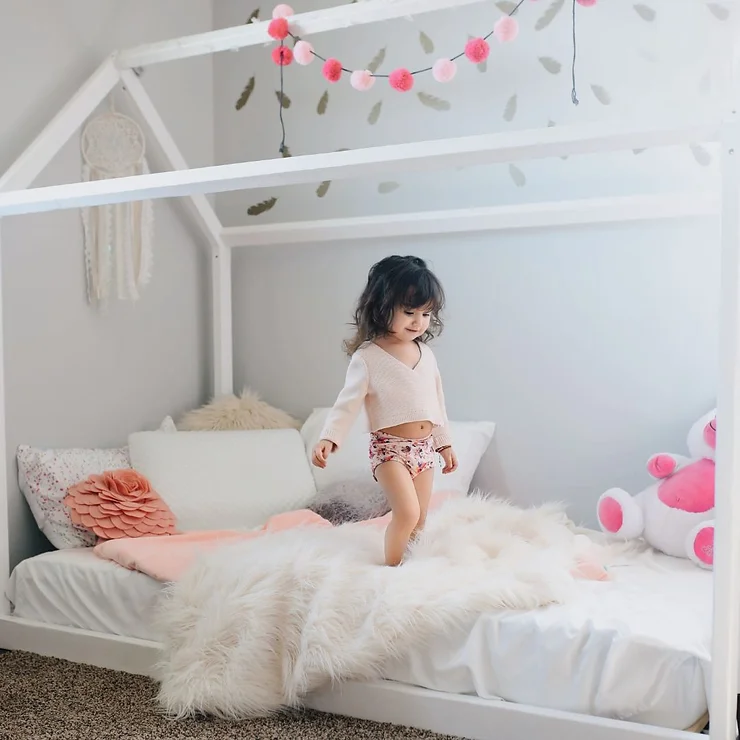Transitioning to a Big Kid Bed
It’s finally time! It’s really exciting! First – make sure you’re not rushing into this transition for the wrong reasons. Here’s some helpful criteria to consider before rushing your child out of their crib.
Signs Your Child is Ready for a Big Kid Bed:
- They are at least 3 years old
- They have strong independent sleep skills
- They are able to understand and follow simple rules
- They are actively and regularly asking for and wanting a big kid bed
- Or…you’ve tried all conservative measures reviewed in my post about crib climbing and your child simply will not quit with their dangerous gymnastics. It’s not idea, but you just have to.
How to Make the Transition Smooth:
Involve Them:
The transition away from the crib and into a big kid bed is big, and with all big transitions, it’s going to be much smoother if you are able to involve your child in the process. Let them watch you modify the crib or move the big bed into the room and set it up. Maybe they can play a role in picking out the bedding too.
Keep the Crib:
While the new bed is coming into the room, it’s not necessary to move the crib out so fast or to dispose of that crib rail. A change of sleep space is a big deal and it can help for your child to know that if the change is too much, they can always go right back to their familiar crib. No big deal. It’s not helpful to add unnecessary pressure if it turns out they do not truly feel ready for this new sleep space. They can always try again when they feel ready.
Safety:
Your big kid may or may not realize it right away, but they are now free to roam! Consider the safety of the entire room with the goal that it is as safe as a giant crib. This might mean securing heavy furniture to walls, locking windows, covering outlets, and removing clutter or excess toys. You might also consider a baby gate or safe external lock on the door to keep them safe in their room during sleep.
Preparation:
Talk about the new transition regularly during wake times, commenting on how most things are the same as always, while also being clear about what is different. Come up with a few simple sleep rules for your child to follow after the end of the bedtime routine. Make sure to include a rule about keeping their body in bed all night long as well as keeping their volume down or voices quiet all the way till morning. Consider an OK to Wake clock to make night vs. morning time crystal clear.
Have a Plan:
It’s pretty typical for this transition to be smooth at first, followed by the child’s realization of their new freedom. This is often followed by increased bedtime resistance, increased night wakings, and increased determination to leave the room! If sleep issues begin to arise, it’s helpful to have a plan.
First ensure the sleep environment is ultra conducive to sleep, that bedtime is appropriately timed, and the bedtime routine is on point. Don’t breeze past this part! True sleep success often relies on those smaller adjustments, which usually mean further darkening the room, shifting bedtime earlier, and firming up the bedtime routine’s predictability.
Finally, the grownups need to agree on a consistent response to leaving the room. Keep the talking, smiling, hugs, tuck ins, yelling, or visible frustration to a minimum. Instead, aim for a silent return with an emphasis on ‘silent’. Save the explanations and reviewing for the next day, and instead hold lovingly firm boundaries around sleep rules to make learning as easy as possible for your big kid.
The silent return might be something you do once, twice, or 100 times. And it’s not likely to work without consistency. If your child’s determination to leave the room is strong, a physical boundary (along with a lot of positive and age appropriate preparation) can be very helpful. Of course there are ways to be more involved in how you respond to your big kid and support them during the learning process. Whether you decide to be more or less present is not nearly as important as the consistency in which you respond.
Most sleep transitions take time to adjust to and it’s helpful to have realistic expectations. Expect some minor sleep issues within the first few months, but don’t expect them to last if you put the effort in to supporting them throughout this transition. The best support to promote your big kid’s healthy sleep is a combination of sleep science, age appropriate preparation, and a consistent response from their loving grownups. Read more about my Top 5 Tips for Healthy Sleep here.
If you’re interested in one-on-one support with a comprehensive and personalized plan specific to your child, schedule a free 15 minute discovery call to learn more about how to improve your child’s sleep and ease this big transition.

